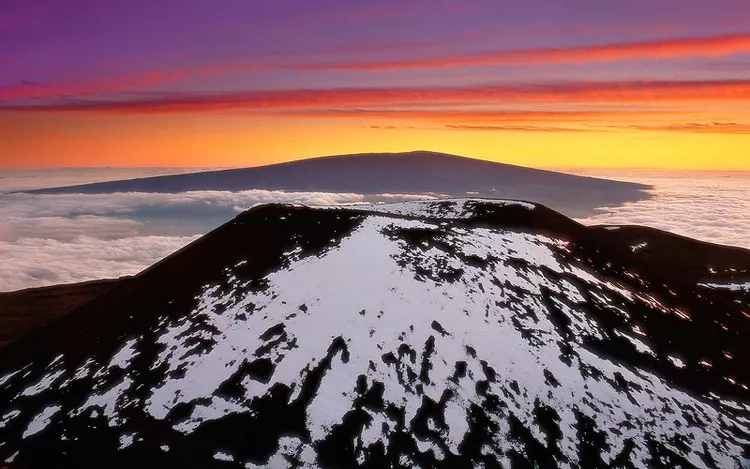Summary
Introduction to Mauna Loa
If visiting the world’s largest volcano sounds dangerous, think again: not all volcanoes erupt with abandon and leave towns covered in molten lava and ash.
While it’s certainly true that volcanoes like Mount Tambora in Indonesia (on record as the world’s deadliest) and Mount Vesuvius in Italy (one of the most active volcanoes in the world) do indeed pose threats, many volcanoes are far less dramatic. Such is the case with Hawaii’s Mauna Loa, which happens to be the world’s largest active volcano, both by volume and size.
After being dormant since 1984, Mauna Loa began to show signs of seismic activity in October 2022 and erupted for the first time in 38 years at 11:30 p.m. on Sunday, Nov. 27. While the volcano’s remote location inside Hawaii Volcanoes National Park means there is no immediate danger to local residents, there have been some in-park road closures as a result of the eruption. Several hiking trails and cabins have also been closed since October 2022 as a precaution.
Nevertheless, it’s still safe to visit Hawaii and its beloved Big Island, though you’ll want to keep an eye on the U.S. Geological Survey’s website if you wish to catch a glimpse of the new lava flows. Hawaii Volcanoes National Park remains open; however, remember to check for updates before you go, as conditions can change rapidly.
Exploring Hawaii
Mauna Loa is located on the Big Island of Hawaii, which is the largest island in the archipelago itself. In the Hawaiian language, its name means “long mountain,” and along with four other volcanoes—Mauna Kea (the tallest volcano on Earth, home to many telescopes and observatories), Kilauea (the one you’ve likely seen photos of with its frequent and powerful eruptions), Hualalai, and Kohala—it forms the very structure of the island.
Mauna Loa is considered to be a shield volcano, which means it was created by the flow of lava over time. Such volcanoes are not particularly tall (at least in the world of volcanoes). Instead, they grow wide like shields. When measured, Mauna Loa’s lava tallies more than 56,000 feet, though its actual elevation is only 13,680 feet.
It’s theorized that the islands of Hawaii began forming 30 million years ago, starting with the first volcanoes erupting through the ocean floor. Geologists estimate that Mauna Loa has been erupting for over 600,000 years and peaked its head above water just 300,000 years ago. Today, Mauna Loa continues to expel lava, thereby adding to the acreage of this ever-expanding island.
Understanding Mauna Loa’s Eruptions
But what can be said about Mauna Loa’s eruptions? While the volcano’s history of eruptions has only been recorded since 1843, geologic evidence over the past 1,000 years suggests that another eruption was always a possibility. Its most recent eruptions tend to manifest as fluid lava flows; during the previous eruption in 1984, the lava flow emerged from the summit and headed downslope toward Hilo, the island’s largest city. While it missed the city limits by roughly four miles, the lava was so bright it illuminated Hilo at night.
So far, the lava from the November 2022 eruption is located within the Northeast Rift Zone. Authorities warn that bits of volcanic glass, fine ash, and a natural phenomenon known as “Pele’s hair”—thin volcanic glass fibers named for the legendary Hawaiian volcano goddess—may be carried downwind. Since it’s a shield volcano, you won’t see dramatic movie-like explosions, but lava appearing through fissures and flowing downhill is still an impressive sight when viewed from a safe distance, such as a lookout point on nearby Kilauea, also part of the national park.
Visiting Hawaii Volcanoes National Park
Mauna Loa continues to attract over one million visitors each year to Hawaii Volcanoes National Park. Come to the park to walk through lava tubes, enjoy more than 150 miles of hiking trails, and watch a volcano or two erupt—Mauna Loa and its neighboring shield volcano, Kilauea, are both currently active (Kilauea since Sept. 29, 2021). It’s advisable to check for the latest updates regarding eruption viewing spots within the national park.
Mauna Loa also holds the distinction of being part of a group of volcanoes known as “Decade Volcanoes,” designated by the International Association of Volcanology and Chemistry of the Earth’s Interior (IAVCEI). These volcanoes continue to be of particular interest due to their high levels of activity and proximity to large population centers. Washington’s Mount Rainier and Sicily’s Mount Etna are also included in this category.
Interestingly, Mauna Loa has competition for the title of the largest volcano on Earth. Roughly 1,000 miles east of Japan lies an extinct underwater volcano named Tamu Massif. Its discovery was announced in 2013; however, in 2019, researchers found that Tamu Massif may actually be a part of a volcanic chain, rather than a single volcano, thereby reinstating Mauna Loa’s title.
As for the tallest volcano on Earth, neighboring Mauna Kea, located on the Big Island of Hawaii, stands just a couple hundred feet higher, surpassing Everest by almost a mile when considering how much of the volcano is submerged below sea level.





